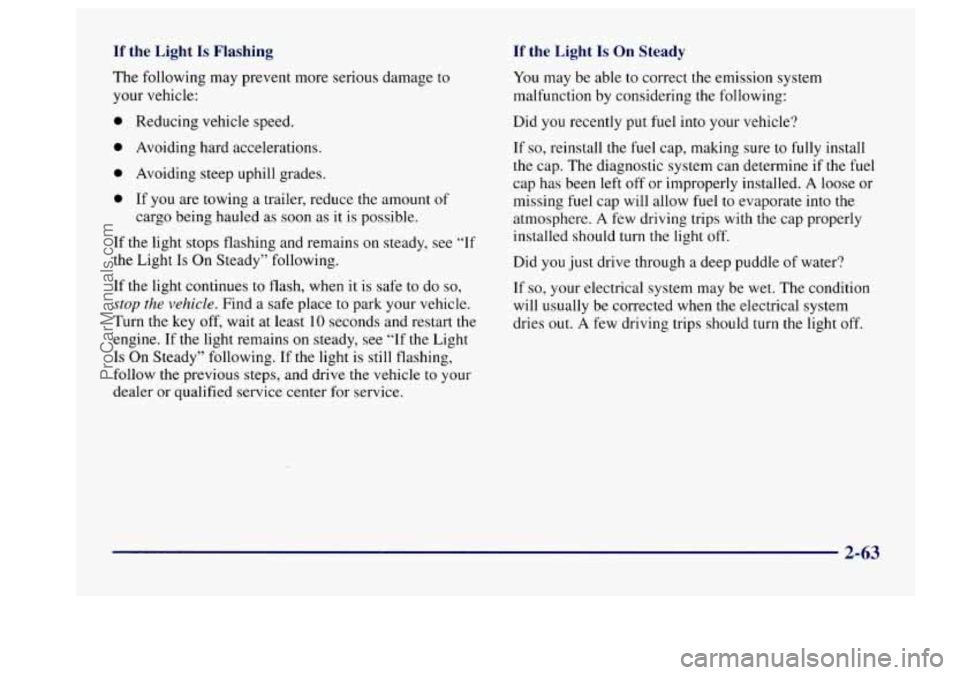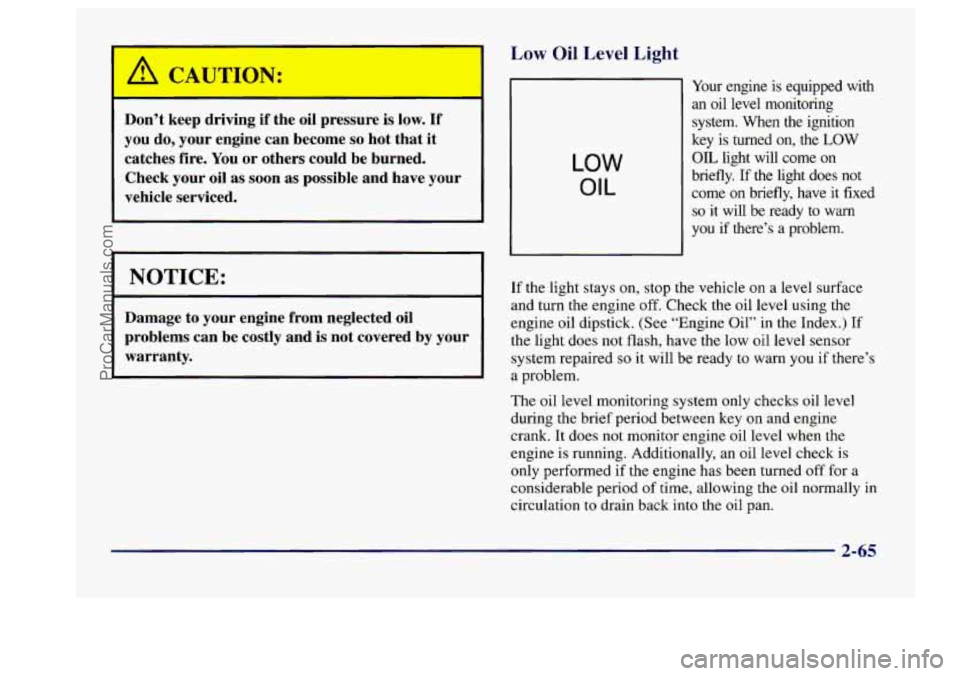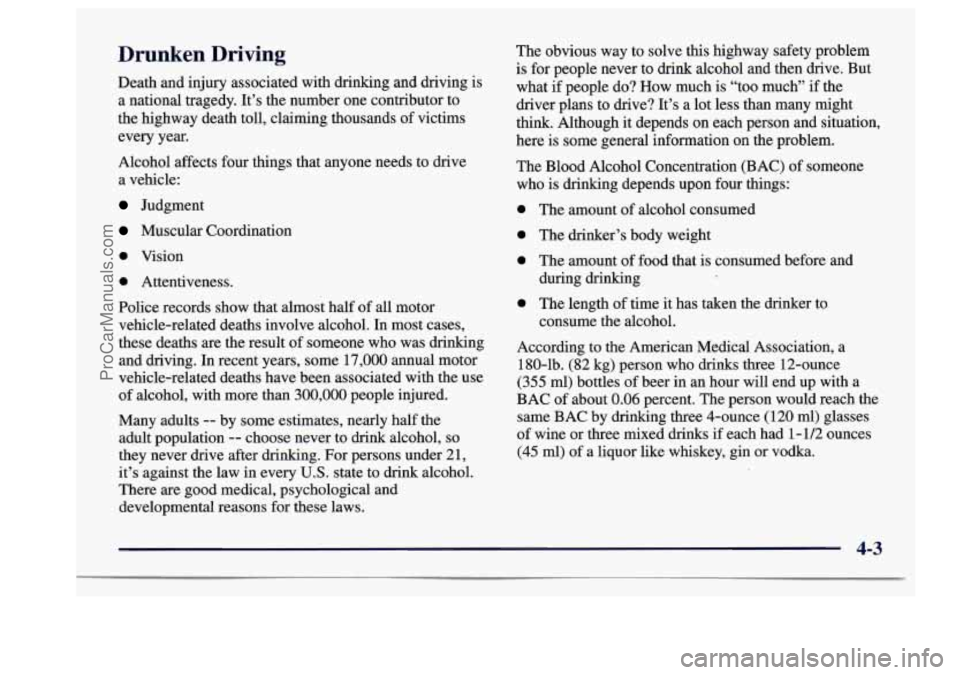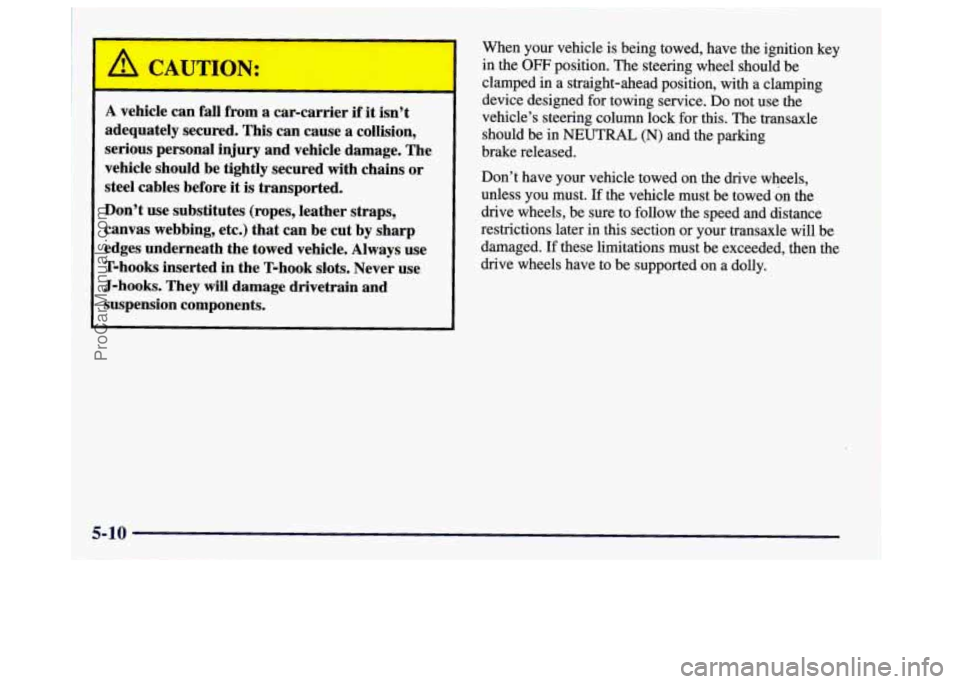Page 137 of 406
Low Coolant Warning Light
LOW COOLANT
If this light comes on, your
system
is low on coolant
and the engine may
overheat. See “Engine
Coolant” in the Index and
have your vehicle serviced
as soon as you can. The
light will come on briefly
when your ignition is turned
on to show
you that it is
working properly.
Low Traction Light
LOW TRAC
When your anti-lock system
is adjusting brake pressure
to help avoid a braking skid,
this light will come on.
(Also see “Anti-Lock Brake
System Active Light”
earlier
in this section.)
Slippery road conditions may exist if the low traction
light comes on,
so adjust your driving accordingly. The
light will stay on for a few seconds after the anti-lock
system stops adjusting brake pressure.
The
LOW TRAC light also comes on briefly when you
turn the ignition key to
RUN. If the light doesn’t come
on then, have it fixed
so it will be there to tell you when
the anti-lock brake system is active.
2-61
ProCarManuals.com
Page 139 of 406

If the Light Is Flashing
The following may prevent more serious damage to
your vehicle:
0 Reducing vehicle speed.
0 Avoiding hard accelerations.
0 Avoiding steep uphill grades.
0 If you are towing a trailer, reduce the amount of
cargo being hauled
as soon as it is possible.
If the light stops flashing and remains on steady, see
“If
the Light Is On Steady” following.
If the light continues to flash, when it is safe to do
so,
stop the vehicle. Find a safe place to park your vehicle.
Turn the key off, wait at least
10 seconds and restart the
engine. If the light remains
on steady, see “If the Light
Is On Steady’’ following.
If the light is still flashing,
follow the previous steps, and drive the vehicle to your
dealer
or qualified service center for service.
If the Light Is On Steady
You may be able to correct the emission system
malfunction by considering the following:
Did you recently put fuel into your vehicle?
If so, reinstall the fuel cap, making sure to fully install
the cap. The diagnostic system can determine if the fuel
cap has been
left off or improperly installed. A loose or
missing fuel cap will allow fuel to evaporate into the
atmosphere.
A few driving trips with the cap properly
installed should turn the light off.
Did you just drive through
a deep puddle of water?
If
so, your electrical system may be wet. The condition
will usually be corrected when the electrical system
dries out.
A few driving trips should turn the light off.
2-63
ProCarManuals.com
Page 141 of 406

Low Oil Level Light
Don’t keep driving if the oil pressure is low. If
you do, your engine can become so hot that it
catches fire. You or others could be burned.
Check your oil
as soon as possible and have your
vehicle serviced.
I NOTICE:
Damage to your engine from neglected oil
problems can be costly and
is not covered by your
warranty.
LOW
OIL
Your engine is equipped with
an oil level monitoring
system. When the ignition
key is turned
on, the LOW
OIL light will come on
briefly.
If the light does not
come on briefly, have it fixed
so it will be ready to warn
you if there’s a problem.
If
the light stays on, stop the vehicle on a level surface
and turn the engine off. Check the oil level using the
engine oil dipstick. (See “Engine Oil” in the Index.) If
the light does not flash, have the low oil level sensor
system repaired
so it will be ready to warn you if there’s
a problem.
The oil level monitoring system only checks oil level
during the brief period between key
on and engine
crank.
It does not monitor engine oil level when the
engine is running. Additionally, an oil level check
is
only performed if the engine has been turned off for a
considerable period of time, allowing the oil normally in
circulation
to drain back into the oil pan.
2-65
ProCarManuals.com
Page 142 of 406

Change Oil Soon Light Security Light
CHANGE OIL
SOON
Your
CHANGE OIL SOON
light should come on as a
bulb check when you start
the engine. If this light stays
on for about 20 seconds
after
you turn on the
ignition, have the
oil chaneed. SECURITY
This light will come on
when
you turn the key to
START and stay on until the
vehicle starts. It will also
flash if your key
is too dirty
or wet for the PASS-Key I1
system to read the resistor
pellet. See “Pass-Key
11” in
the Index.
When to change your oil also depends
on driving habits
and conditions because they directly affect engine speed,
coolant temperature and vehicle speed. Because of this,
the
CHANGE OIL SOON light may come on as early as
2,000 miles (3,200 km) or less for harsh conditions.
Remember, after changing your engine oil, the system
must be reset; with the ignition key
in the RUN position,
but
the engine off, fully push and release the accelerator
pedal three times within five seconds.
If the CHANGE
OIL SOON light flashes two times, the system is reset.
However
if the light comes on and stays on for five
seconds,
it did not reset. You’ll need to reset the
system again. If
the resistor pellet is damaged or missing, the light will
come on.
If you’re driving and the SECURITY light comes on
and remains on, your PASS-Key I1 system is not
working properly. Your vehicle is not protected by
PASS-Key
11, and you should see your dealer.
2-66
ProCarManuals.com
Page 189 of 406

Drunken Driving
Death and injury associated with drinking and driving is
a national tragedy. It’s the number one contributor to
the highway death toll, claiming thousands of victims
every year.
Alcohol affects four things that anyone needs to drive
a vehicle:
Judgment
Muscular Coordination
0 Vision
0 Attentiveness.
Police records show that almost half
of all motor
vehicle-related deaths involve alcohol. In most cases,
these deaths
are the result of someone who was drinking
and driving. In recent years, some 17,000 annual motor
vehicle-related deaths have been associated with the use
of alcohol, with more than
300,000 people injured.
Many adults
-- by some estimates, nearly half the
adult population
-- choose never to drink alcohol, so
they never drive after drinking. For persons under 21,
it’s against the law in every
U.S. state to drink alcohol.
There
are good medical, psychological and
developmental reasons for these laws. The
obvious way to solve this highway safety problem
is for people never to
hnk alcohol and then drive. But
what
if people do? How much is “too much” if the
driver plans to drive? It’s a lot less than many might
think. Although it depends on each person and situation,
here is some general information on the problem.
The Blood Alcohol Concentration (BAC)
of someone
who is drinking depends upon four things:
0 The amount of alcohol consumed
0 The drinker’s body weight
0 The amount of food that is consumed before and
during drinking
consume the alcohol.
0 The length of time it has taken the drinker to
According to the American Medical Association, a
180-lb. (82 kg) person who drinks three 12-ounce
(355 ml) bottles of beer in an hour will end up with a
BAC
of about 0.06 percent. The person would reach the
same BAC by drinking three 4-ounce
(120 ml) glasses
of wine or three mixed drinks if each had
1 - 1/2 ounces
(45 ml) of a liquor like whiskey, gin or vodka.
4-3
ProCarManuals.com
Page 228 of 406
Hazard Warning Flashers
.- c
Your hazard warning flashers let you warn others. They
also let police know you have
a problem. Your front and
rear turn signal lamps will flash
on and off. Press the switch on top
of
the steering column
to make
your front and rear turn
signal lamps flash on and
off. Your hazard warning
flashers work no matter
what position your key is in;
they even work
if the key
isn’t in the ignition.
To turn off the flashers, press the switch again. When
the hazard warning flashers are on, your turn signals
won’t work.
Other Warning Devices
If you carry reflective triangles, you can set one up at
the side
of the road about 300 feet (100 m) behind
your vehicle.
5-2
ProCarManuals.com
Page 236 of 406

r I A CAUTION:
A vehicle can fall from a car-carrier if it isn’t
adequately secured. This can cause a collision,
serious personal injury and vehicle damage. The
vehicle should be tightly secured with chains or
steel cables before
it is transported.
Don’t use substitutes (ropes, leather straps,
canvas webbing, etc.) that can be cut by sharp
edges underneath the towed vehicle. Always use
T-hooks inserted in the T-hook slots. Never use
J-hooks.
They will damage drivetrain and
suspension components.
When your vehicle is being towed, have the ignition key
in the
OFF position. The steering wheel should be
clamped in a straight-ahead position, with a clamping
device designed for towing service. Do not use the
vehicle’s steering column lock for
this. The transaxle
should be in
NEUTRAL (N) and the parking
brake released.
Don’t have your vehicle towed on the drive wheels,
unless you must.
If the vehicle must be towed on the
drive wheels, be sure to follow the speed and distance
restrictions later in this section or your transaxle will be
damaged. If these limitations must be exceeded, then the
drive wheels have
to be supported on a dolly.
5-10
ProCarManuals.com
Page 325 of 406
Fuse
23 24
26 27
28
29
30
31
32
Description
Cigarette Lighter -- Auxiliary
Power Connection, Data Link
Stoplamps
Parklamps Auxiliary Power Connection
--
Hot in ACC and Run
Crank Signal
-- Body Control
Module, Cluster, Powertrain
Control
Modules
Ignition Signal -- HVAC
Control Head
Brake Transmission
Shift Interlock
Air Bag
Anti-lock Brake Controls, Body
Control Module
Fuse
33
34
36
37
38
39
40
41
42
43
44
45
Description
Hazard Flashers
Not Used
Ignition Signal
-- Hot in ACC and
Run
-- Body Control Module
Anti-lock Brake Solenoids
Low Blower
Anti-lock Brakes
Turn Signals Radio,
HVAC head, Keyless Entry,
Cluster
High Blower
Not Used
Steering Wheel Controls
Wipers
6-59
ProCarManuals.com